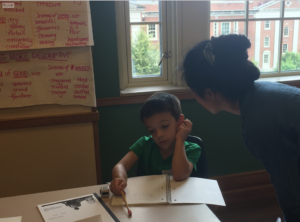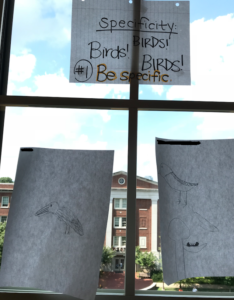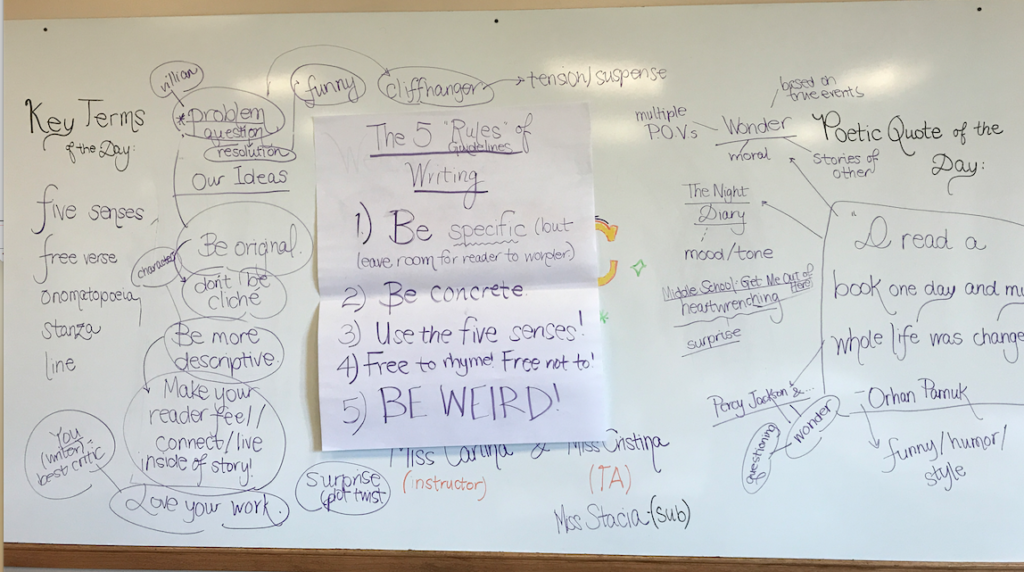Summer SAVY 2018: Session 5, Day 1 – Poetic Play (Rising 3rd/4th)
Dear Parents:
Hello, and welcome to Poetic Play! I am so thrilled to begin this wondrous week with such talented, brilliant and creative young writers — thank you for your trust in giving me the opportunity to work with your students. I can’t wait to see what poetic creations we stir up as the week continues!
First! An overview: This week, we will be working on introducing your writers to poetic concepts such as: figurative language, metaphor/similie, onomatopoeia, meter, rhyme, free verse — and offering them general tactics/techniques they can use and apply to ALL writing, including prose. Students will build a literary vocabulary and community within the classroom, and will have opportunities to apply their learning of concepts into their own writing, reading, and literary conversations. We’ll be reading a wide range of poets — both classical and contemporary — including William Shakespeare, Walt Whitman, Lemony Snicket, Shel Silverstein, and Franz Wright, to name a few. Students will be encouraged to think critically and creatively about their writing, and, in turn, respond to the world around them through a poetic lens.
Each day, I’ll give a short summary of what we’ve done in class throughout the day, and include optional discussion questions (relevant to our class activities) for you and your child to think about as dinnertime convo, on the car ride home, etc.
So! Without further ado:
Happy Monday. We had an amazing first day of class today!
In the morning, students were introduced to the classroom space, and given a brief overview of the week and the day’s schedule. We had a mini icebreaker activity (involving the question, “If you could fill an inflatable pool with anything, what would you fill it with, and why?”) to get to know one another. Students then completed Concept Maps in order to view their entering knowledge of the subject of poetry.
Students were then invited to consider the Quote of the Day, written on the board: “I read a book one day and my whole life was changed,” by Turkish novelist Orhan Pamuk. Students had an opportunity to reflect upon this quote, agree or disagree with it, offer examples of books they may have read that have been transformative, and share within their seating groups. We then discussed this quotation as a class, bringing in different books we’ve read — The Night Diary, Wonder, Percy Jackson series (examples your students brought in!) — and deciphering what specific literary elements those books used to draw us in as readers. Some examples of literary elements that authors may use, in order to create books that transform us: Humor, wonder/questioning, descriptive detail to conjure mood, surprise, offering morals or lessons, and introducing new perspectives.
Students were then introduced to the five “Rules,” or guidelines, of Writing — useful ways to think about our work as we spend time together this week.
- Be specific;
- Be concrete;
- Use the five senses;
- Free to rhyme/Free not to!;
- (my favorite) — BE WEIRD!
We discussed the Lemony Snicket quote, “Because all great literature is strange, the way all good slides are slippery,” and contemplated the quality of “weirdness” — flipping a familiar image back into something fresh, exciting — that might create “exciting” or “good” poems.
After their Recreational time (ORA), students completed an activity called “Specificity: Birds! Birds! Birds!” Students were asked to draw a “Bird” without letting other students see their drawings first. These drawings were then displayed around the room, and all students completed a “gallery walk” of observing their classmates’ drawings, taking notes in their Writers’ Notebooks on what they saw. We came together as a class to discuss the differences in all of our birds (some, for example, ate worms; some birds were drawn flying mid-air; some had sloping beaks, some had curved ones), and what we might do as WRITERS to make sure we all imagined a similar bird (specific detail!).
We moved on to building our Great Word Wall, whereupon students learned new vocabulary terms that will be utilized in our class, and applied to discussions about poetry: stanza, couplet, line, speaker. Students used their vocabulary to talk about the poem “The Witch Has Told You A Story,” by Ava Leavell Haymon. This poem is a literary adaptation of the traditional fairytale Hansel & Gretel. As a class, we observed specific “vibrant verbs and juicy adjectives” that compose the poem and make it seem fresh, exciting, alive. We discussed the plot of the poem, and our inferences about what might happen to the speaker as she/he moves throughout the poem.
Next up! A class lesson on Onomatopoeia, where students were introduced to the concept of forming sound-words associated with their names (ex: cuckoo, sizzle). Students were asked to imagine different Onomatopoeia words in different settings: the kitchen, the zoo, and underwater, and wrote their thoughts on the board under a classroom “Onomatopoeia Word Bank.”
I then read a published poem I have written, “JIF,” to the students, where we discussed different onomatopoeia language within this poem. Students had some writing time and were encouraged to think about a recent summer memory, and then write a short four-line poem using onomatopoeia within it.
In the afternoon, the class read the book “This Is A Poem That Heals Fish” by Jean-Pierre Siméon out loud together. We wondered: What makes up a poem? What are the elements that make poems so strange, so delightful? We discussed Free Verse. Students then created their own short free-verse poems using a template from “This Is A Poem That Heals Fish,” and using sensory language, image, and onomatopoeia. There were some FANTASTIC lines that were written into air today, including: “A poem is when she sloshes and drip-drops while making her coffee,” and, “A poem is when she crunches into her chicken sandwich.” !! I love all the possibility and strangeness that poem-making allows for! We continued adding to our Onomatopoeia Word Bank on the walls, which we will keep filling in as the week goes on.
We transitioned into an out-loud reading of two stanzas of a very advanced(!) poem — “Song of Myself,” by Walt Whitman, the so-called “father of free verse.” Students were introduced to Whitman’s legacy on American Poetry. Together, we unpacked the beginning two stanzas of “Song of Myself,” discussing Whitman’s poem as a celebration of himself in nature, and relating to the natural world. We also reviewed how Whitman applies the five guidelines of writing into his own work, and looked for specific in-text examples.
Finally, we crafted our own “songs of OURselves,” using Whitman as a model. In order to do this, students were invited to create their own interpretive paint shapes (using this method), and were encouraged to create a short, lyric poem relating their shape back to themselves, or “celebrating themselves.”
OPTIONAL QUESTIONS / FURTHER THOUGHTS FOR YOUR STUDENTS: If you’d like to engage your students more in thinking about the “five guidelines” of writing tonight, I’d encourage you to ask them to pay attention to different specific sights, tastes, noises, touches, and/or scents they notice at dinner tonight. You might ask them to brainstorm even more onomatopoetic words they hear at the dinner table, on their ride home, etc. In tandem with our class discussion on reading transforming our worlds, students can think about the following: How do writers use tools we’ve learned today to transform their writing? Describe your evening using a string of onomatopoeia words!
Thank you for a fabulous first day! I’m looking forward to tomorrow.
All best,
Miss Carlina
Some Photos From Our Day



